Serviços Personalizados
artigo
Indicadores
Compartilhar
Revista de Psicología (Lima)
versão impressa ISSN 0254-9247
Rev. psicol. (Lima) vol.35 no.1 Lima jan./jun. 2017
http://dx.doi.org/10.18800/psico.201701.004
ARTÍCULOS
Psychometric Properties of the Alexithymia Questionnaire for Children in a Peruvian Sample of Adolescents1
Propiedades psicométricas del cuestionario de alexitimia para niños en una muestra peruana de adolescentes
Propriedades psicométricas do questionário de alexitimia para crianças, numa amostra peruana de adolescentes
Karen Yearwood2, Nicole Vliegen3, Patrick Luyten4, Cecilia Chau5, Jozef Corveleyn6, Katholieke Universiteit Leuven- Belgium2,3,4,6, Pontificia Universidad Católica del Perú5
1 Acknowledgments to Carolien Rieffe, Leiden University, The Netherlands, for providing the original Dutch and English versions of the Alexithymia Questionnaire for Children and to the "Fonds Dr. Pierre Vereecken" from the University KU Leuven for providing funding for this research project.
2 Master of Science, Leuven Statistics Research Centre, KU Leuven, and PhD candidate in the Faculty of Psychology and Educational Sciences, KU Leuven. Address: Tiensestraat 102 - box 3720, 3000 Leuven, Belgium. Contact: karen.yearwood@kuleuven.be.
3 PhD. and Associate Professor in the Faculty of Psychology and Educational Sciences, KU Leuven, Leuven, Belgium. Address: Tiensestraat 102 - box 3722, 3000 Leuven, Belgium. Contact: nicole.vliegen@kuleuven.be.
4 PhD. and Associate Professor in the Faculty of Psychology and Educational Sciences, KU Leuven, Leuven, Belgium and in the Research Department of Clinical, Educational and Health Psychology, University College London, UK. Address: Tiensestraat 102 - box 3722, 3000 Leuven, Belgium. Contact: patrick.luyten@kuleuven.be.
5 PhD. and Associate Professor in the Department of Psychology, Pontificia Universidad Católica del Perú (PUCP), Lima, Perú. Address: Av. Universitaria 1801, San Miguel, Lima 32, Perú. Contact: cchau@pucp.edu.pe.
6 PhD. and Emeritus Professor in the Faculty of Psychology and Educational Sciences, KU Leuven, Leuven, Belgium. Address: Tiensestraat 102 - box 3722, 3000 Leuven, Belgium. Contact: jozef.corveleyn@kuleuven.be.
ABSTRACT
The concept of alexithymia refers to impairments in the ability to identify and communicate feelings. Alexithymia has repeatedly been linked to attachment impairments and different types of symptomatology, in particular, depression and somatic complaints. Very few studies have focused on children or adolescents when addressing this construct. Additionally, to date, there is no self-report questionnaire of alexithymia for such groups in the Spanish language. The main objectives of this study were therefore, (a) to translate and adapt the Alexithymia Questionnaire for Children to Spanish; (b) to assess the factor structure of the adapted questionnaire; and (c) to describe its reliability and validity, in a sample of N = 265 Peruvian adolescents aged 11-18 years. Internal consistency was acceptable for the DIF subscale (α = .74), and low for the DDF and EOT subscales (α = .55, and α = .47 respectively). A composite scale based on previous studies that merges DIF and DDF into one scale had an α = .75. Regarding the factor structure, a two–factor solution showed to have the best fit with the data (RMSEA = .05, SMRM = .04, CFI = .94). Convergent validity analyses indicated significant associations between alexithymia and attachment measurements (that ranged from r = - .15, p < .05, to r = .31, p < .05), somatic complaints (r = .38, p < .05, to r = .41, p < .05), and both internalizing and externalizing symptoms (r = .37, p < .05, to r = .46, p < .05). Future assessment and modifications are recommended for the EOT scale.
Keywords: alexithymia, mentalizing, adolescents, attachment, symptoms.
RESUMEN
El concepto de alexitimia se refiere a las deficiencias en la capacidad de identificar y comunicar sentimientos. Este constructo ha sido relacionado con deficiencias en apego y con diferentes tipos de sintomatología, en particular, con depresión y quejas somáticas. Muy pocos estudios sobre alexitimia se han enfocado en niños o adolescentes. Además, hasta la fecha, no existe ningún cuestionario de auto-reporte de alexitimia para tales grupos en español. Por lo tanto, los principales objetivos de este estudio fueron, (a) traducir y adaptar el Cuestionario de Alexitimia para Niños al español; (b) evaluar la estructura factorial del cuestionario adaptado; y (c) describir su confiabilidad y validez, en una muestra de n = 265 adolescentes peruanos de 11-18 años de edad. La consistencia interna fue aceptable para la subescala DIF (α = .74), y baja para las subescalas DDF y EOT (α = .55 y α = .47, respectivamente). Una escala compuesta basada en estudios previos que fusiona las subescalas DIF y DDF en una sola escala tuvo un α = .75. En cuanto a la estructura factorial, una solución de dos factores demostró tener el mejor ajuste con la data (RMSEA = .05, SMRM = .04, CFI = .94). Los análisis de validez convergente indicaron asociaciones significativas entre alexitimia y apego (con coeficientes desde r = -.15, p <.05, hasta r = .31, p <.05), quejas somáticas (r = .38, p <.05, hasta r = .41, p <.05), y síntomas internalizantes y externalizantes (r = .37, p <.05, hasta r =. 46, p <.05). Se recomienda la evaluación y/o modificación de la escala EOT.
Palabras clave: alexitimia, mentalización, adolescentes, apego, síntomas.
RESUMO
O conceito de alexitimia se refere às deficiências na habilidade de identificar e comunicar sentimentos. A alexitimia tem sido frequentemente associada à deficiências de apego e diferentes tipos de sintomatologia, em particular à depressão e queixas somáticas. Pouquíssimos estudos dão enfoque à crianças ou adolescentes ao tratar desse conceito. Além disso, até o momento não há questionários de autorrelato em espanhol sobre alexitimia para tais grupos. O objetivo principal deste estudo foi, portanto, (a) traduzir e adaptar o "Alexythymia Questionnaire for Children" para o espanhol; (b) avaliar a estrutura de fatores do questionário adaptado; e (c) descrever sua confiabilidade e validade numa amostra de N=265 adolescentes peruanos de 11 a 18 anos de idade. A consistência interna mostrou-se aceitável para a subscala DIF (α = .74), e baixa nas subscalas DDF e EOT (α = .55, e α = .47 respectivamente). Umaescala composta, baseada em estudos anteriores, combina DIF e DDF numa única escala e apresentou α = .75. Em termos da estrutura de fatores, uma solução de dois fatores foi a que melhor se ajustou aos dados (RMSEA ==.05, SMRM = .04, CFI = .94). Análises de validade convergentes indicaram associações significantes entre alexitimia e medidas de apego (as quais variaram de r = -.15, p < .05, a r = .31, p < .05), queixas somáticas (r = .38, p < .05, a r = . 41, p < .05), e sintomas internalizantes e externalizantes (r = .37, p < .05, to r = . 46, p < .05). Avaliações futuras e modificações são recomendadas para a escala EOT.
Palavras-chave: alexitimia, mentalização, adolescentes, apego, sintomas.
The concept of alexithymia refers to difficulties in the identification and description of feelings and is related to impairments in emotional self-regulation (Larsen, Brand, Bermond, & Hijman, 2003) and emotional awareness (Luyten, Van Houdenhove, Lemma, Target, & Fonagy, 2013). These type of deficiencies are strongly associated with impairments in mentalizing, or, in other words, to a lack of mentalizing capacities. Mentalizing capacities can be operationalized as a form of social cognition that implies the ability to perceive and interpret human behavior in terms of intentional mental states (Luyten, Fonagy, Lowyck, & Vermote, 2012; Luyten & Fonagy, 2015). Mentalizing is a multidimensional concept, which has been categorized in four dimensions (each organized on two opposing polarities): self–other, cognitive–affective, internal–external, and automatic–controlled. Alexithymia (measured as difficulty in identifying and describing feelings) refers to deficits among the self, cognitive–affective, internal, and controlled facets of mentalizing (Luyten et al., 2012; Luyten & Fonagy, 2015).
The presence of alexithymia is strongly related to early negative life experiences such as adversity, trauma, and vulnerability (Smith, Kouros, & Meuret, 2014). Fonagy, Gergely, Jurist, and Target (2002) have suggested that there is an association between early adversity and childhood trauma and impairments in reflective capacities (i.e., the capacity to mentalize). Similarly, Luyten et al. (2013) reported that high levels of alexithymia were associated with a history of trauma and emotional neglect. In addition, Joukamaa et al. (2007) found an association between alexithymia and disadvantageous living conditions, suggesting that higher alexithymia levels would be related to poverty and harsh environments.
The importance of having reliable tools for the measurement of alexithymia is related to the fact that these type of impairments play an important role in the development of various psychiatric disorders and problems of psychological functioning (Allen, Fonagy, & Bateman, 2008; Fonagy & Luyten, 2009). Among them, depression-related symptoms (Di Schiena, Luminet, & Philippot, 2011; Sagardoy, Solórzano, Morales, Kassem, & Codesal, 2014), anxiety (Bratis et al., 2010), interpersonal problems such as cold/distant and nonassertive social functioning (Hesse & Floyd, 2011; Humphreys, Wood, & Parker, 2009; Meins, Harris-Waller, & Lloyd, 2008; Vanheule, Desmet, Meganck, & Bogaerts, 2007), functional somatic disorders (Allen, Qian Lu, Tsao, Hayes, & Zeltzer, 2011; Jones et al., 2013; Luyten et al., 2011), and executive dysfunction (Koven & Thomas, 2010) have been broadly studied.
Only recently have studies of the concept of alexithymia been focused on child and adolescent populations. Different studies have found a prevalence of between 7% and 18 % of clinical alexithymia among adolescents when using a cutoff point to determine whether individuals are alexithymic or non-alexithymic (Joukamaa et al., 2007; Gatta et al., 2014).
Most published research on alexithymia in children and adolescents has focused on associations between alexithymia and internalizing symptoms (e.g., somatic disorders) and/or pathological attachment patterns. The link between alexithymia and somatic complaints among children has been repeatedly established (Jellesma, Rieffe, Terwogt, & Westenberg, 2009). Insecure and disorganized attachment in children have been associated with deficiencies in internal state language and the vocabulary of emotion and cognition (Lemche, Klann-Delius, Koch, & Joraschky, 2004). Similarly, higher levels of alexithymia have been encountered among anxious and avoidant children and adolescents than insecurely attached groups (Oskis et al., 2013). Only limited research has been carried out in the Spanish language, and to our knowledge, no studies have been conducted with self-report measures of alexithymia specifically designed for Spanish-speaking populations of children and adolescents. Most of the Spanish language research related to the construct of alexithymia has used the adult version of the TAS-20 (Cruz-Saez, Pascual, Etxebarria, & Echeburua, 2013).
The Alexithymia Questionnaire for Children, the first self-report measure of alexithymia for children, which is based on the TAS20, was published in 2006 (Rieffe, Oosterveld, & Terworgt, 2006). It was originally published in English and Dutch, and has more recently been validated in Italian, Hindi, and Farsi (Di Trani et al., 2009; Mishra, Maudgal, Theunissen, & Rieffe, 2012; Rieffe et al., 2010). To date, no Spanish version has been validated.
As we know that mentalizing impairments are closely related on the one hand to a history of vulnerability and trauma, and on the other hand to a broad range of symptomatology across the lifespan, we strongly believe that having a valid measurement of this construct for children is necessary for developmental research specifically related to concepts such early adversity, trauma, and attachment. Therefore, the main objectives of this study were: (a) to translate and adapt the Alexithymia Questionnaire for children to Spanish; (b) to assess the factor structure of the adapted questionnaire; and (c) to describe its psychometric properties, in terms of reliability and validity. Additionally, the predictive value of the instrument was assessed, in terms of somatic complaints, and internalizing and externalizing symptomatology, among a sample of adolescents.
Method
Due to the lack of research regarding alexithymia in adolescents, and in particular in Peru, this study is considered to be a descriptive, psychometric study, analyzing the properties of the Alexithymia Questionnaire for Children in a sample of Peruvian adolescents. The main objectives of this study were, therefore, to provide with a Spanish version of the self-report questionnaire of alexithymia for such groups, to assess its factor structure, and to describe its psychometric properties.
Participants
The current study was part of a larger longitudinal study about childhood trauma and adolescent mental health in Lima, Peru. A subsample of 265 adolescents aged between 11 and 18 years (M = 14.15, SD = 1.50) that completed the alexithymia questionnaire at the first time of data collection (that was part of a pilot study) was considered for this cross-sectional study. Data collection took place at a public high school in Villa El Salvador, Lima, Peru. Equal gender distribution was aimed for, achieving a final sample of 50.2% boys and 49.8% girls.
Measures
Alexithymia. The Toronto Alexithymia Scale (TAS-20; Bagby, Parker, & Taylor, 1994) is a 20-item self-report instrument measuring alexithymia. The questionnaire consists of three subscales: Difficulty Describing Feelings (DDF), Difficulty Identifying Feelings, (DIF) and Externally Oriented Thinking (EOT). Items are rated using a 5-point Likert scale where 1 = strongly disagree, and 5 = strongly agree. Good internal consistency (α = .81) and test–retest reliability (.77, p < .01) have been found for the overall scale, as well as adequate levels of convergent and concurrent validity. In addition, the instrument has been found to be stable and replicable across clinical and nonclinical populations (Bagby et al., 1994). The Child version of the TAS-20 (the Alexithymia Questionnaire for Children) was developed in 2006 (Rieffe et al., 2006). This instrument was developed with a careful adaptation of the items to be more comprehensible, and age appropriate for children (9 years of age and older) and was originally published in English and Dutch. The child version is rated using a 3-point Likert scale where 1 = not true, and 3 = often true. The original instrument internal consistency indices were: DIF, α = .73; DDF, α = .75; and EOT, α = .29.
Symptomatology. The Youth Self Report (YSR; Achenbach & Rescorla, 2001) is a self-administered questionnaire for adolescents between 11 and 18 years of age. It contains 112 items, 16 of which ask about the frequency of socially desirable behaviors. The YSR verifies eight first-order syndromes: Anxious/Depressed, Withdrawn/ Depressed, Somatic Complaints, Social Problems, Thought Problems, Attention Problems, Rule-breaking Behavior, and Aggressive Behavior.
This first-order syndromes cluster into two second-order factors: the Internalizing Dimension covers anxiety and depression syndromes, and the Externalizing Dimension includes behavior problems, substance abuse, and hyperactivity. For this study, the somatic complaints syndrome, and the internalizing and externalizing clusters were considered. The YSR has been used in a wide variety of cultures (Ivanova et al., 2007; Rescorla et al., 2007) and shows adequate psychometric properties based on evidence of its validity, reliability, and temporal stability (Achenbach & Rescorla, 2001; Achenbach et al., 2008; Hofstra, Van der Ende, & Verhulst, 2002). Lemos, Vallejo, and Sandoval (2002) adapted and validated a Spanish version of the YSR. The Spanish version was acquired for this study through the Achenbach System of Empirically Based Assessment. In our study, we found an internal consistency index of α =. 80 for the somatic complaints syndrome, α = .89 for the internalizing cluster and α = .93 for the externalizing cluster.
Parental Attachment. The Inventory of Parent and Peer Attachment (IPPA; Armsden & Greenberg, 2009) is a 75-item self-report questionnaire that measures the perceived quality of attachment of teenagers to their parents and peers. The instrument assesses three dimensions: trust, communication, and alienation. Good internal consistency coefficients have been reported for the revised version of the three scales: mother attachment α = .87, father attachment α =. 89, and peer attachment α =. 92 (Armsden & Greenberg, 2009). The revised IPPA was translated into Spanish in Colombia (Pardo, Pineda, Carrillo, & Castro, 2006) and its psychometric properties were established. The internal consistency indices for this Spanish version were: mother scale α = .90, father scale α = .93, and peer scale α = .90. For this study, only the mother and father scales of the Spanish version were considered.
Procedure
Adolescents were recruited by a public high school, after having received a signed consent of the school authorities. The students were provided with information about the aims of the study and ethical considerations. In particular, confidentiality and anonymity were ensured, as well as protection of the privacy of participants. Participants were allowed to stop their involvement with the study at any point, and they were offered psychological counseling if needed. Students who voluntarily agreed to participate signed an informed consent form, followed by the oral and written instructions about the procedure. Then, they completed the self-report questionnaires during class hours. The overall (longitudinal) project was approved by the KU Leuven University Social and Societal Ethics Committee.
The adaptation process of the instrument followed commonly used guidelines for instrument adaptation (Beaton, Bombardier, Guillemin, & Ferraz, 2000) and recommendations of the International Test Commission. The English version of the Alexithymia Questionnaire for Children was translated into Spanish and then reviewed by an expert panel. Modifications were made in order to maintain conceptual meaning and to incorporate cultural adaptations to Peruvian Spanish. Next, the back translation was performed, and the back-translated version was compared with the original English and Dutch versions of the instrument.
Data Analysis
Regarding the data processing, first, preliminary analyses and descriptive statistics were conducted. Then, the factor structure and dimensionality of the instrument were assessed using confirmatory factor analyses (CFA), and measurement reliability was estimated with internal consistency indices. Finally, convergent validity was explored by analyzing the associations between alexithymia, and both attachment (parental trust, communication, and alienation) and symptomatology, (somatic complaints, internalizing and externalizing symptoms) among adolescents.
For confirmatory factor analyses, Mplus Version 6.12 was used. For all other analyses, IBM SPSS version 22 was used. Theoretical fit indices were considered to interpret the model fit of the CFA approach. A model fit was considered acceptable if RMSEA < .07, SRMR < .08, and CFI and TLI > .90 (Hooper, Coughlan, & Mullen, 2008). Additionally, an alternative model (AM) approach to CFA (Byrne, 2012) was used, allowing for the testing of alternative models based on previous studies. In this case, the compared models were a three-factor model versus a two-factor model.
Results
Factor Structure
Factorial analysis has been proposed as one of the best methods to assess an instrument’s structure and dimensionality (León, 2012). Using this method, previous studies exploring the internal structure of the TAS-20 consistently found poor functioning of the EOT scale in both the adult and the child versions of the instrument (Gignac, Palmer, & Stough, 2007; Mishra et al., 2012; Rieffe et al., 2010; Thorberg et al., 2010). We expected to find similar results, and therefore, took an AM approach to CFA (Byrne, 2012). In line with such an approach, we estimated two different models in order to compare the theoretical three-factor structure versus the two-factor structure, based on previous studies (Mishra et al., 2012; Rieffe et al., 2010). The three-factor solution had a poor model fit, whereas the two-factor solution showed a good fit with the data and had only a small local misfit regarding two items. The confirmatory analyses findings are summarized in Table 1.

As shown in Table 1, the two-factor solution (including only DIF and DDF subscales) had a very good fit with the data, while estimates for the three-factor CFA showed an unacceptable model fit. Items 4 and 12 had factor loadings lower than the .4 cutoff point (Stevens, 1992). Standardized factor loadings for both models are shown in Table 2.
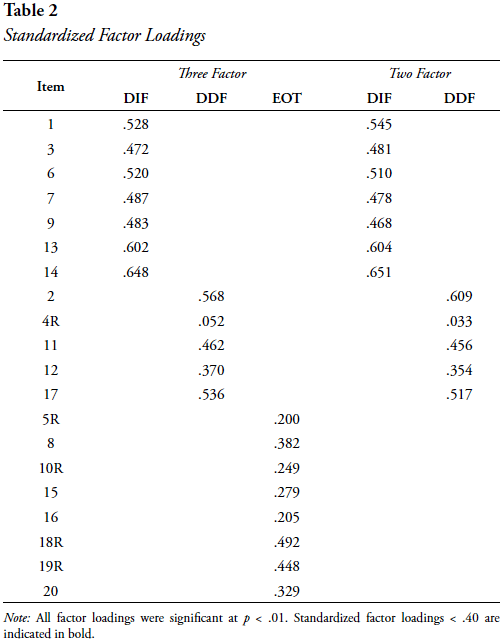
Descriptive Statistics and Internal Consistency
The means, standard deviations, skewness, kurtosis, and internal consistency estimates (Cronbach’s alphas) of the Alexithymia Questionnaire for Children are presented in Table 3. Reliability was acceptable for the DIF scale, with α of .74, and low for the DDF and EOT subscales (α =.55 and .47 respectively). Nevertheless, according to current criteria to assess internal consistency (George & Mallery, 2003), the DDF reliability estimate is considered low but not unacceptable. In addition, this low estimate can be attributed to the fact that there are only five items on the scale. For this reason, some studies (Mishra et al., 2012) have used a composite measure that merges the DIF and DDF items into one scale. If a composite measure of DIF and DDF were to be considered, the internal consistency for such combined scale would be α = .75. Similar to findings of several previous studies (Mishra et al., 2012; Rieffe et al., 2006, 2010) the EOT scale had poor reliability within the Peruvian sample.
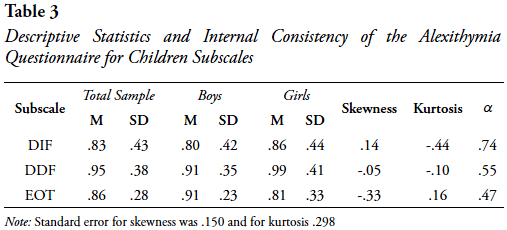
Independent samples t-tests were conducted to test for gender differences among the mean levels of the subscales. No significant differences were found among boys and girls for either of the subscales. Finally, correlations between subscales were as follows: DIF and DDF, r = .50, p <.01; EOT was not significantly correlated to either DIF or DDF.
Convergent Validity
To assess convergent validity, the associations between alexithymia and both attachment and symptomatology (in terms of somatic complaints and internalizing and externalizing symptoms) were explored. Zero-order correlations are presented in Table 4, which shows the correlations between the alexithymia subscales and parental attachment measures (communication, trust, and alienation), and Table 5, which shows the associations between the alexithymia subscales and symptomatology.
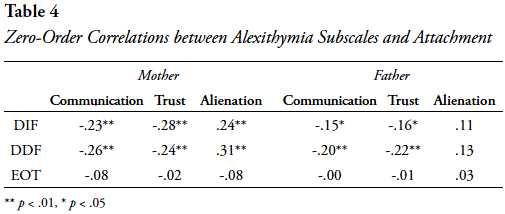
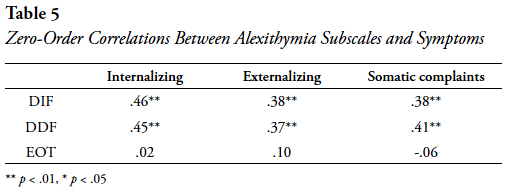
Additionally, three multiple linear regressions were conducted to predict symptoms from gender, age, and alexithymia (considering only DIF and DDF, based on the previous results of correlations, reliability, and factor structure). In the case of internalizing symptoms, both age and alexithymia statistically significantly predicted internalizing symptoms among adolescents, F(4, 209) = 22.55, p < .001, R2 = .30, while gender did not have a significant effect. Age and alexithymia added significantly to the prediction, p < .05, with standardized Betas of β =.16 (age), β =.30 (DIF), and β =.25 (DDF), respectively. Similarly, for externalizing symptoms, both age and alexithymia significantly predicted externalizing symptoms among adolescents, F(4, 209) = 13.55, p < .001, R2 = .21, while gender did not have a significant effect. Age and alexithymia added significantly to the prediction, p < .05, with standardized Betas of β = .16 (age), β = .23 (DIF), and β = .21 (DDF). Finally, for somatic complaints, both gender and alexithymia significantly predicted somatic complaints among adolescents, F(4, 209) = 15.54, p < .001, R2 = .23, while age did not have a significant effect. Gender and alexithymia added significantly to the prediction, p < .05, with standardized Betas of β = .13 (gender), β = .21 (DIF), and β = .28 (DDF).
Discussion
This study provides supportive evidence of the validity of the DIF and DDF subscales of the Alexithymia Questionnaire for Children, in a Spanish-speaking Latin American population. Results about the third subscale, EOT, demonstrate its poor functioning and low reliability, and are comparable to results of other studies (Gignac et al., 2007; Mishra et al., 2012; Rieffe et al., 2010). Difficulty identifying feelings is understood as an individual’s impairment for distinguishing between feelings and bodily sensations of states of emotional arousal; and difficulty describing feelings is understood as an individual’s impairment for communicating subjective feelings to others. These types of impairments are considered to be cognitive alexithymia, and are highly related to each other (Bagby, Parker, & Taylor, 1994). Nevertheless, externally oriented thinking is defined as a disposition to focus on external rather than internal events and experiences, and in this sense it could be more related to a personality trait, and does not necessarily carry the same negative connotation as the other two scales. Therefore, we strongly advise future research to further investigate whether to drop the EOT subscale from this instrument or to explore new possible items to constitute it.
Although the DIF and DDF scales showed to have a good combined reliability estimate, as well as a good fit with the data in terms of factor structure, local misfit was found regarding two items. The two malfunctioning items (item 4: "I can easily say how I feel inside" and item 12: "Other people tell me that I should talk more about how I feel inside") correspond to the DDF scale. It seems likely that this result can be attributed to ambiguity within the phrase "how I feel inside", making it difficult for this sample to understand the intended meaning of these items. A previous study in Peru has found that the socioeconomic level is significantly related to the way in which people interpret emotions; and that a lower socio economic status is associated to a lower presence of complex emotions, which in turn might be related to a more limited vocabulary (Traverso & Nóblega, 2012). Considering that our sample is characterized by a low socio economic status, we hypothesize that this element might be related to the poor functioning of these two items and therefore to the lower reliability estimate of the DDF subscale on our internal consistency analyses. There are cultural differences that influence the meaning of words that are utilized to describe concepts related to emotions (Moscoso & Spielberger, 2011) and this is a topic to be considered when adapting an instrument to a different language and setting. In that sense, we recommend the use of a focus group for qualitative interpretation of the Spanish translation of these two items.
Convergent validity analyses supported previous findings suggesting a clear association between alexithymia, parental attachment, and adolescent symptomatology. On one hand, attachment related problems have been identified as a potential cause for alexithymia, while symptomatology (in particular, depression and somatic complaints) has been identified within the literature as a potential outcome of alexithymia.
Regarding parental attachment, we found a negative association between alexithymia and both paternal and maternal trust and communication. Additionally, we found a positive association between alexithymia and maternal alienation. These findings imply a relationship between maladaptive attachment patterns and cognitive alexithymia (difficulties identifying and describing feelings). Even though the measure of parental attachment used on this study was dimensional and not style-based, these results are comparable to others that found a positive association between alexithymia and pathologic attachment styles. For example, a recent study found significant associations between the inability to analyze, identify, and verbalize emotions, and insecure attachment strategies (Koelen, Eurelings-Bontekoe, Stuke, & Luyten, 2015). Similarly, Oskis and colleagues, (2013) found higher levels of alexithymia among anxious and avoidant insecurely attached groups of adolescents compared to the securely attached participants. Furthermore, they reported that the anxious attachment style significantly predicted alexithymia scores, indicating that early-life disruptions on the attachment process could have an effect on emotional awareness and self-regulation during adolescence.
The advantage of using a dimensional measure of parental attachment instead of a style-based measure is the possibility of having an insight on protecting factors. The negative attachment patterns are indeed directly related to alexithymia, but the positive dimensions of parental attachment such as trust and communication, are significantly and negatively associated to this construct. These positive dimensions of parental attachment could be furthered studied as protective factors, or as variables with a potential for future intervention.
On the subject of symptomatology, alexithymia appeared to be positively related to somatic complaints and internalizing and externalizing symptoms. Nevertheless, again, these associations remained only related to the DIF and DDF subscales, whereas EOT appeared to have no significant associations with such measures. The association between alexithymia and internalizing symptoms has been repeatedly reported, in particular related to depression-related symptoms (De Berardis et al., 2010, Di Schiena, Luminet, & Philippot, 2011; Sagardoy, Solórzano, Morales, Kassem, & Codesal, 2014), and functional somatic disorders (Allen, Qian Lu, Tsao, Hayes, & Zeltzer, 2011; Luyten et al., 2011; Jones et al., 2013). Nevertheless, it is important to consider that even though we found these associations, general measures of distress like internalizing and externalizing symptoms, are affected by a complex range of elements and cannot be reduced to bivariate analyses. In the particular case of this Peruvian sample, those elements include not only individual vulnerabilities such as alexithymia, but also contextual factors (like poverty and community violence). Not only the presence of general distress, but the presence of alexithymia itself has also been linked to contextual factors, such as poverty, harsh environments (Joukamaa et al., 2007), early adversity, and trauma (Smith, Kouros, & Meuret, 2014).
The inclusion for other variables (both from the adolescents and from their environment), and of multivariate analyses, could give better insight into these associations. In this regard, the present study and its adaptation of the Alexithymia Questionnaire for Children to the Peruvian (Lima) context can be a steppingstone towards more complex research questions and analyses. Having a valid measure for alexithymia for children and adolescents in Spanish-speaking populations may be valuable to understand the effect of mentalizing impairments on developmental trajectories of such children. In particular, having this measure in a developing country like Peru, which has a long history of political and social conflicts as well as harsh socioeconomic conditions, is likely to be highly relevant to trauma-related research, because such mentalizing impairments may mediate the effect of trauma and adversity on mental health.
Overall, the results of this study suggest that the Spanish adaptation of the Alexithymia Questionnaire for Children is a reliable tool, when considering the modifications on the factor structure, and the specific use of DIF and DDF subscales. On the basis of the findings of this study, the authors recommend the use of the Alexithymia Questionnaire for Children as an instrument for assessing alexithymia and mentalizing impairments among adolescents. However, it is important to note that the concept of mentalizing is multidimensional and context-specific. Therefore, when focusing on the assessment of mentalizing, it is necessary to consider its four dimensions and the impact of different settings or contexts (Luyten et al., 2012; Luyten & Fonagy,2015), such as the level of stress arousal and the individual’s attachment history. Consequently, a proper evaluation of this concept should take into account different stress conditions and different relationships where attachment patterns and activation–deactivation strategies in response to stress may change (Luyten et al., 2012; Luyten & Fonagy, 2015). Accordingly, we recommend the use of this questionnaire in combination with other instruments that assess attachment and the other facets of mentalizing.
Conclusions and Limitations
This study is the first to assess the psychometric properties of a self-report questionnaire about alexithymia for children in a Spanishspeaking population. Results confirm previous findings and suggest that the DIF and DDF subscales of the instrument are stable across countries and are associated with different symptoms and attachment patterns among children and adolescents.
Several limitations of the present study should be acknowledged. First, the results are not to be generalized or extrapolated to other populations, and can be considered only for adolescents attending public schools in Lima, Peru. Second, even though the sample size was strong enough to claim validity estimates, a larger sample size would provide with more generalizable results. Third, the measurements used were self-report instruments, possibly implying an information bias. Although most of the research regarding alexithymia has used self-report measures, an increasing number of studies include neurobiological measures to assess the relationship between the cognitive and emotional characteristics of alexithymia and psychosomatic and psychiatric disorders (Larsen et al., 2003). Finally, given that the study was cross-sectional it was not possible to assess the stability of the instrument via test–retest reliability.
While acknowledging these limitations and the deficiencies within the EOT scale, the results that emerge from our analyses, taken together with those reported from earlier studies, provide preliminary evidence for the use of the Alexithymia Questionnaire for Children among Spanish-speaking populations. However, we recommend the use of only the DIF and DDF subscales, either as separate constructs or as a merged alexithymic factor.
Recommendations for future research include a qualitative evaluation of the EOT subscale and the Spanish DDF items (in particular items 4 and 12). Moreover, we suggest the psychometric assessment of the instrument in different Spanish-speaking populations, as well as a longitudinal assessment of reliability.
REFERENCES
Achenbach, T. M., Becker, A., Döpfner, M., Heiervang, E., Roessner, V., Steinhausen, H., & Rothenberger, A. (2008). Multicultural assessment of child and adolescent psychopathology with ASEBA and SDQ instruments: research findings, applications, and future directions. Journal of Child Psychology and Psychiatry, and Allied Disciplines, 49(3), 251-75. https://doi.org/10.1111/j.1469-7610.2007.01867.x. [ Links ]
Achenbach, T.M., & Rescorla, L.A. (2001). Manual for the ASEBA school-age forms & profiles. Burlington, VT: University of Vermont, Research Center for Children, Youth, & Families. [ Links ]
Allen, J.G., Fonagy, P., & Bateman, A.W. (2008). Mentalizing in clinical practice. Washington, DC: American Psychiatric Press. [ Links ]
Allen, L.B., Qian Lu, Tsao, J.C.I., Hayes, L.P., & Zeltzer, L.K. (2011). Depression partially mediates the relationship between alexithymia and somatization in a sample of healthy children. Journal of Health Psychology, 16(8), 1177-1186. https://doi.org/10.1177/1359105311402407. [ Links ]
Armsden, G., & Greenberg, M. (2009). The inventory of parent and peer attachment: Preliminary Test Manual. (Available from M.T. Greenberg, College of Health and Human Development, Pennsylvania State University, University Park, PA). [ Links ]
Bagby, R.M., Parker, J.D., & Taylor, G.J. (1994). The twenty-item Toronto Alexithymia Scale--I. Item selection and cross-validation of the factor structure. Journal of Psychosomatic Research, 38(1), 23-32. https://doi.org/10.1016/0022-3999(94)90005-1. [ Links ]
Beaton, D.E., Bombardier, C., Guillemin, F., & Ferraz, M.B. (2000). Guidelines for the process of cross-cultural adaptation of self-report measures. Spine, 25(24), 3186-3191. https://doi.org/10.1097/00007632-200012150-00014. [ Links ]
Bratis, D., Spanopoulou, A., Dumitru, S., Lagou, S., Diamandi, C., Tselebis, A., & Kosmas, E. (2010). Sleep disturbance symptoms and their associations with alexithymia, depression and anxiety. Annals of General Psychiatry, 9, 1. https://doi.org/10.1186/1744859X-9-S1-S163. [ Links ]
Byrne, B.M. (2012). Structural equation modeling with Mplus : basic concepts, applications, and programming. Multivariate applications series. New York: Routledge. [ Links ]
Cruz-Saez, M.S., Pascual, A., Etxebarria, I., & Echeburua, E. (2013). Riesgo de trastorno de la conducta alimentaria, consumo de sustancias adictivas y dificultades emocionales en chicas adolescents. [Risk for eating disorders, use of addictive substances, and emotional difficulties among girl adolescents]. Anales de Psicologia, 29(3), 724-733. https://doi.org/10.6018/analesps.29.3.151041. [ Links ]
De Berardis, D., Serroni, N., Campanella, D., Moschetta, F. S., Ranalli, C., Olivieri, L., & Di Giannantonio, M. (2010). Alexithymia, somatic complaints and depressive symptoms in a sample of italian adolescents: preliminary results of a one-year longitudinal study. European Psychiatry, 25(1),405. doi: http://dx.doi.org/10.1016/S0924-9338(10)70401-6.
Di Schiena, R., Luminet, O., & Philippot, P. (2011). Adaptive and maladaptive rumination in alexithymia and their relation with depressive symptoms. Personality and Individual Differences, 50(1), 10-14. https://doi.org/10.1016/j.paid.2010.07.037. [ Links ]
Di Trani, M., Tomassetti, N., Bonadies, M., Capozzi, F., De Gennaro, L., Presaghi, F., & Solano, L. (2009). Un Questionario Italiano per l’Alessitimia in Eta Evolutiva: struttura fattoriale e attendibilita. [An Italian Questionnaire for Alexithymia in Developmental Age: factor structure and reliability]. Psicologia Della Salute, 2, 131-143.
Fonagy, P., Gergely, G., Jurist, E., & Target, M. (2002). Affect regulation, mentalization, and the development of the self. New York, NY: Other Press. [ Links ]
Fonagy, P., & Luyten, P. (2009). A developmental, mentalization-based approach to the understanding and treatment of borderline personality disorder. Development and Psychopathology, 21, 1355-1381. https://doi.org/10.1017/S0954579409990198. [ Links ]
Gatta, M., Facca, I., Colombo, E., Svanellini, L., Montagnese, S., & Schiff, S. (2014). Alexithymia, Psychopathology and Alcohol Misuse in Adolescence: A Population Based Study on 3556 Teenagers, Neuroscience & Medicine, 5, 60-71. https://doi.org/10.4236/nm.2014.51009. [ Links ]
George, D., & Mallery, P. (2003). SPSS for Windows step by step: A simple guide and reference. 11.0 update (4a ed.). Boston, MA: Allyn & Bacon. [ Links ]
Gignac, G.E., Palmer, B.R., & Stough, C. (2007). A confirmatory factor analytic investigation of the TAS-20: corroboration of a five-factor model and suggestions for improvement. Journal of Personality Assessment, 89(3), 247-257. https://doi.org/10.1080/00223890701629730. [ Links ]
Hesse, C., & Floyd, K. (2011). Affection mediates the impact of alexithymia on relationships. Personality and Individual Differences, 50(4), 451-456. https://doi.org/10.1016/j.paid.2010.11.004. [ Links ]
Hofstra, M.B., Van der Ende, J., & Verhulst, F.C. (2002). Pathways of Self-Reported Problem Behaviors From Adolescence Into Adulthood. American Journal of Psychiatry, 159(3), 401-407. https://doi.org/10.1176/appi.ajp.159.3.401. [ Links ]
Hooper, D., Coughlan, J., & Mullen, M. (2008). Structural Equation Modelling: Guidelines for Determining Model Fit Structural equation modelling: guidelines for determining model fit. Electronic Journal of Business Research Methods, 6(1), 53-60. [ Links ]
Humphreys, T.P., Wood, L.M., & Parker, J.D. a. (2009). Alexithymia and satisfaction in intimate relationships. Personality and Individual Differences, 46 (1), 43-47. https://doi.org/10.1016/j.paid.2008.09.002. [ Links ]
Ivanova, M.Y., Achenbach, T.M., Rescorla, L.A., Dumenci, L., Almqvist, F., Bilenberg, N., Verhulst, F.C. (2007). The generalizability of the Youth Self-Report syndrome structure in 23 societies. Journal of Consulting and Clinical Psychology, 75(5), 729-38. https://doi.org/10.1037/0022-006X.75.5.729. [ Links ]
Jellesma, F.C., Rieffe, C., Terwogt, M.M., & Westenberg, M. (2009). Do I feel sadness, fear or both? Comparing self-reported alexithymia and emotional task-performance in children with many or few somatic complaints. Psychology & Health, 24(8), 881-893. https://doi.org/10.1080/08870440801998970. [ Links ]
Jones, M.P., Coppens, E., Vos, R., Holvoet, L., Luyten, P., Tack, J., & Van Oudenhove, L. (2013). A multidimensional model of psychobiological interactions in functional dyspepsia: a structural equation modelling approach. Gut, 62(11), 1573-1580. https://doi.org/10.1136/gutjnl-2012-302634. [ Links ]
Joukamaa, M., Taanila, A., Miettunen, J., Karvonen, J.T., Koskinen,M., & Veijola, J. (2007). Epidemiology of alexithymia among adolescents. Journal of Psychosomatic Research, 63, 373-376. https://doi.org/10.1016/j.jpsychores.2007.01.018. [ Links ]
Koelen, A., Eurelings-Bontekoe, E., Stuke, F., & Luyten, P. (2015). Insecure attachment strategies are associated with cognitive alexithymia in patients with severe somatoform disorder. The International Journal of Psychiatry in Medicine,49(4), 264-278. https://doi.org/10.1177/0091217415589303. [ Links ]
Koven, N.S., & Thomas, W. (2010). Mapping facets of alexithymia to executive dysfunction in daily life. Personality and Individual Differences, 49 (1), 24-28. https://doi.org/10.1016/j.paid.2010.02.034. [ Links ]
Larsen, J. K., Brand, N., Bermond, B., & Hijman, R. (2003). Cognitive and emotional characteristics of alexithymia: a review of neurobiological studies. Journal of Psychosomatic Research, 54, 533-541. https://doi.org/10.1016/S0022-3999(02)00466-X. [ Links ]
Lemche, E., Klann-Delius, G., Koch, R., & Joraschky, P. (2004). Mentalizing language development in a longitudinal attachment sample: Implications for alexithymia. Psychotherapy and Psychosomatics, 73(6), 366-374. https://doi.org/10.1159/000080390. [ Links ]
Lemos, S., Vallejo, G., & Sandoval, M. (2002). Estructura factorial del Youth Self-Report (YSR). [Factorial Structure of the Youth Self-Report (YSR)]. Psicothema, 14, 816-822. [ Links ]
León, A. (2012). La unidimensionalidad de un instrumento de medición: perspectiva factorial. [The unidimensionality of a measuring instrument: factorial perspective]. Revista de Psicología, 24(1), 53-80. [ Links ]
Luyten, P., & Fonagy, P. (2015). The neurobiology of mentalizing. Personality Disorders: Theory, Research and Treatment, 6(4)., 366-379. https://doi.org/10.1037/per0000117. [ Links ]
Luyten, P., Fonagy, P., Lowyck, B., & Vermote, R. (2012). The assessment of mentalization. In A. Bateman & P. Fonagy (Eds.), Handbook of mentalizing in mental health practice (pp. 43-65). Washington, DC: American Psychiatric Association. [ Links ]
Luyten, P., Kempke, S., Van Wambeke, P., Claes, S., Blatt, S. J., & Van Houdenhove, B. (2011). Self-critical perfectionism, stress generation, and stress sensitivity in patients with chronic fatigue syndrome: relationship with severity of depression. Psychiatry, 74(1), 21-30. https://doi.org/10.1521/psyc.2011.74.1.21. [ Links ]
Luyten, P., Van Houdenhove, B., Lemma, A., Target, M., & Fonagy, P. (2013). Vulnerability for functional somatic disorders: A contemporary psychodynamic approach. Journal of Psychotherapy Integration, 23(3), 250-262. https://doi.org/10.1037/a0032360. [ Links ]
Meins, E., Harris-Waller, J., & Lloyd, A. (2008). Understanding alexithymia: Associations with peer attachment style and mindmindedness. Personality and Individual Differences, 45(2), 146-152. https://doi.org/10.1016/j.paid.2008.03.013. [ Links ]
Mishra, V.S., Maudgal, S., Theunissen, S. C. P. M., & Rieffe, C. (2012). Alexithymia in children with cancer and their siblings. Journal of Psychosomatic Research, 72(4), 266-268. https://doi.org/10.1016/j.jpsychores.2011.12.007. [ Links ]
Moscoso, M. & Spielberger, C.(2011). Cross-cultural assessment of emotions: The expression of anger. Revista de Psicología, 29(2), 344-360. [ Links ]
Oskis, A., Clow, A., Hucklebridge, F., Bifulco, A., Jacobs, C., & Loveday, C. (2013). Understanding alexithymia in female adolescents: The role of attachment style. Personality and Individual Differences, 54 (1), 97-102. https://doi.org/10.1016/j.paid.2012.08.023.
Pardo, M., Pineda, S., Carrillo, S., & Castro, J. (2006). Análisis psicométrico del inventario de apego con padres y pares en una muestra de adolescentes colombianos. [Psychometric analysis of the Parent and Peer Attachment Inventory in a sample of Colombian adolescents]. Interamerican Journal of Psychology, 40(3), 289-302.
Rescorla, L., Achenbach, T. M., Ivanova, M. Y., Dumenci, L., Almqvist, F., Bilenberg, N., & Verhulst, F. (2007). Epidemiological comparisons of problems and positive qualities reported by adolescents in 24 countries. Journal of Consulting and Clinical Psychology,75(2), 351-358. https://doi.org/10.1037/0022-006X.75.2.351. [ Links ]
Rieffe, C., Oosterveld, P., Meerum Terwogt, M., Novin, S., Nasiri, H., & Latifian, M. (2010). Relationship between alexithymia, mood and internalizing symptoms in children and young adolescents: Evidence from an Iranian sample. Personality and Individual Differences, 48(4), 425-430. https://doi.org/10.1016/j.paid.2009.11.010. [ Links ]
Rieffe, C., Oosterveld, P., & Terwogt, M. M. (2006). An alexithymia questionnaire for children: Factorial and concurrent validation results. Personality and Individual Differences, 40(1), 123-133. https://doi.org/10.1016/j.paid.2005.05.013. [ Links ]
Sagardoy, R.C., Solórzano, G., Morales, C., Kassem, M.S., & Codesal, R. (2014). Procesamiento emocional en pacientes TCA adultas vs. adolescentes. Reconocimiento y regulación emocional. [Emotional processing in adult TCA patients vs. teenagers. Recognition and emotional regulation]. Clínica y Salud, 25(1), 19-37. https://doi.org/10.1016/S1130-5274(14)70024-6.
Smith, N.B., Kouros, C. D., & Meuret, A. E. (2014). The role of trauma symptoms in nonsuicidal self-injury. Trauma, Violence & Abuse, 15(1), 41-56. https://doi.org/10.1177/1524838013496332. [ Links ]
Stevens, J. P. (1992). Applied Multivariate Statistics for the Social Sciences (2nd edition). NJ: Erlbaum.: Hillsdale. [ Links ]
Thorberg, F.A., Young, R.M., Sullivan, K.a, Lyvers, M., Hurst, C., Connor, J. P., & Feeney, G. F. X. (2010). A confirmatory factor analysis of the Toronto Alexithymia Scale (TAS-20) in an alcohol-dependent sample. Psychiatry Research, 178(3), 565-567. https://doi.org/10.1016/j.psychres.2009.09.015. [ Links ]
Traverso, P., & Nóblega, M. (2012). El Infant Facial Expressions of Emotions from Looking at Pictures. Versión peruana. [The Infant Facial Expressions of Emotions from Looking at Pictures. Peruvian version]. Revista de Psicología, 30(2), 317-340. [ Links ]
Vanheule, S., Desmet, M., Meganck, R., & Bogaerts, S. (2007). Alexithymia and interpersonal problems. Journal of Clinical Psychology, 63, 109-117. https://doi.org/10.1016/j.sbspro.2010.07.153. [ Links ]
Appendix 1. Alexithymia Questionnaire for Children - Spanish Version
La forma en que me siento
En la siguiente página, encontrarás 20 oraciones cortas. Cada oración es un enunciado acerca de cómo las personas pueden sentirse o pensar. Marca con un círculo la opción de respuesta que mejor se ajusta para ti (si esto es frecuentemente cierto, a veces cierto o no es cierto para ti). No hay respuestas correctas o incorrectas, ya que se trata solo sobre lo que tú piensas.
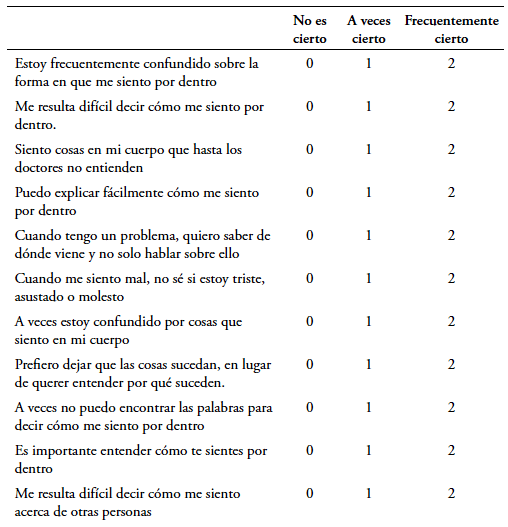
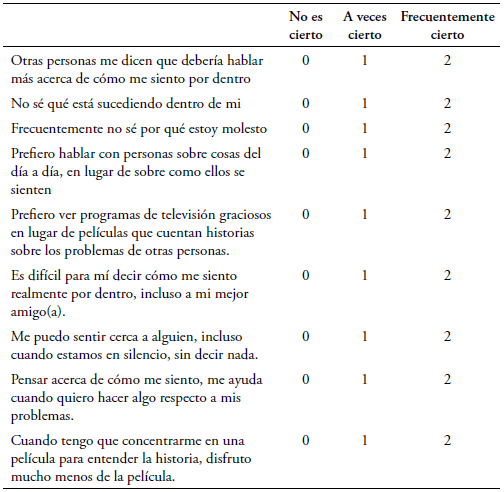
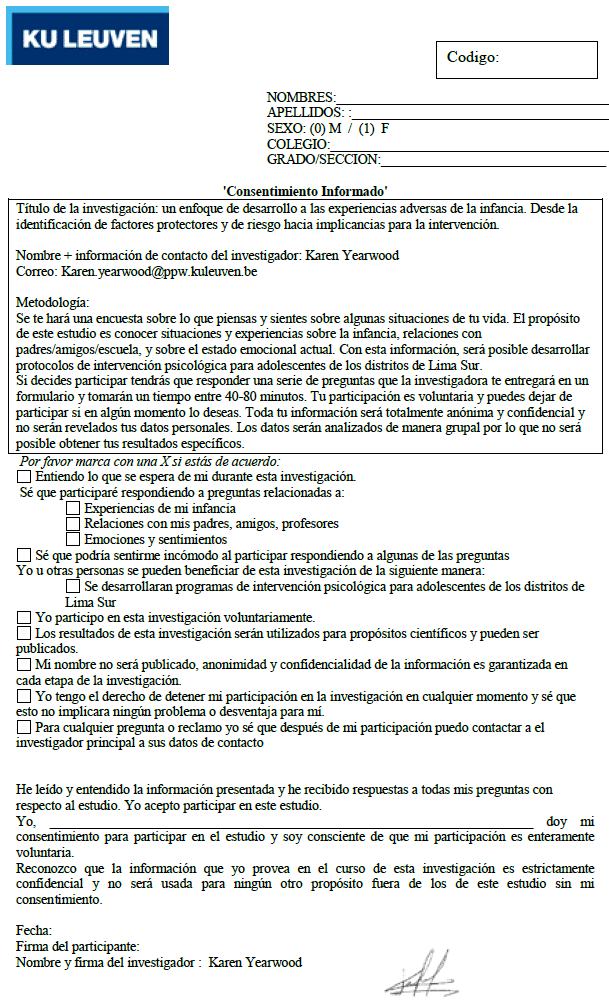
Recibido: 19 de noviembre, 2015
Revisado: 17 de mayo, 2016
Aceptado: 16 de junio, 2016














